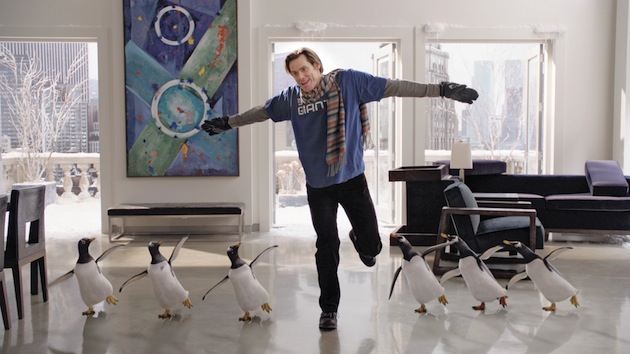I frequently explain to my students that many folks outside the user experience industry—especially management—think as follows: “I am human, I factor … therefore, I can do human factors.” And many times when these self-nominated experts espouse a specific implementation that matches their perspective, they speak from complete ignorance.
At these times, the UX engineer wants a simple guide, rooted in commonly understood references to explain human factors engineering and UX design.
This Hollywood series of articles (in case you missed the previous articles, see Tom Cruise, Johnny Depp, Tom Hanks, and Laura Dern) provides that guide, using pop culture to lead the way.
So let’s proceed with our next god of cinematic lessons: Jim Carrey.
Lesson #1: Silent Analytics Can Help Tailor Your UX
“God, please give me a sign.”
In the hit 2003 movie Bruce Almighty, Carrey plays a disgruntled journalist who, in the midst of incessant complaining about God is granted almighty powers for a week. After addressing his selfish needs, he creates a computer program that logs the prayers of people into a sortable inbox so he can address their silent wishes individually or collectively. When he attempts to do the latter without tailoring his actions for each person, he unknowingly creates havoc.
The utopia of Bruce’s inbox is achievable: customer behavior may at times be stealthy measured and analyzed, either using internal customer data or external tools. For instance, OnStar/GM went back through millions of records and analyzed the crash rate for normal driving and “within call” driving to determine that hands-free calling did not affect the primary task of driving. With that customer data, they were able to announce that GM’s product offering didn’t adversely affect driver inattention (a.k.a. driver distraction) and, therefore, should not be a target of government mandates and attacks.
As an example of an external tool, Oopgo offers a real-time web tool where history or even live actions by flagged customers can quietly provide interaction analytics, website heat maps, and the like for the UX engineer to understand failings or task completion within his website. Stealth web-analytics such as those were applied in the classic “$300 Million Button,” where a corporation overcame large website dropout rates by changing a button from “Login” to “Continue”—increasing revenue by 45%.
But just like with Bruce Almighty, here’s the lesson: don’t assume that macro-analysis, though powerful, will allow for micro-understanding. If you use a tool like Oopgo, you must comprehend the desired goal of your user and see if your solution addresses his or her needs. In the $300 Million Button example, the drop-out customers weren’t confused by the usability; they simply desired unhindered product surfing and were frustrated with early hurdles of signing-in.
Use stealth monitoring, but understand the masses via individualistic comprehension. With that type of insight, you will certainly be omnipotent!
Lesson #2: Know the Business Side of Your Business
“Show business. Show business. Without the business, there is no show.”
Andy Kaufman was a comedic genius. Yes, his style was uniquely odd and full appreciation possibly required a few drinks under your belt, but the movie Man on the Moon skillfully depicts his distinctive rise to fame. In one early scene, Carrey, playing Kaufman, finishes his set having believed there was a communal sense of his entertainment value, but the bar owner explains that beauty is in the eye of the beholder … and it wasn’t pretty.
This lesson can be applied to any discipline—from administration to zoology—but seems particularly applicable to UX engineering: unless your organization truly understands your unique value, you’re likely to get booed offstage. For many UXers, the belief is: “Surely they see my great work and know I’m doing something most folks couldn’t do.” Nope. You’re arranging pictures and words. At least that’s how the electrical engineers of the world see you. They could do what you do. Other engineers save $1-per-part on a million parts and can attach a tangible value to their triumphs. What you do isn’t that special … or so they think.
So here’s the punchline: make sure they understand in dollars and cents the worth of your work. If your latest design moved novice task completion from 70% to 95%, that’s worth an incremental $8 million by extrapolating current sales. If repositioning the core product on the corporate website improved the heat index by 5% for the company’s 10 million hits, you’ve just improved profits by $12 million. Even if your statistics seem overly boastful, you must demonstrate your value in this fashion. Otherwise, it fades into oblivion and management never appreciates your true importance.
Show the business of your show business and they’ll appreciate what makes you uniquely valuable.
Lesson #3: Watch Out for the X+1 Factor
“Second thoughts are as valid as first thoughts. They just come later.”
Tom Popper is a successful corporate crusader. Early in Mr. Popper’s Penguins, he encounters a nearly-retired building owner who, based on private soul-searching, sound calculation, and deliberate forethought is unwilling to sell his downtown skyscraper. In a scene that only Hollywood could create, Popper injects his opinion via an emotionally-driven story, playing upon the older gentleman’s passions to weaken his resolve and reverse his decision. At the onset of the discussion, Popper leads with the quote, “Second thoughts are as valid as first thoughts. They just come later.” And with that, he uses his second thoughts to ultimately reshape the elder’s resolution.
If I had a nickel for every time an influential, opinionated, charasmatic, and outspoken stakeholder approached a finalized design after usability testing was complete with the supposedly-magical ingredient, I’d have 1,001 nickels. I refer to this as the “X+1 Factor”—the decision reached by “X” engineers using scientific data and great forethought can be overturned by the “+1” person entering the meeting. Yes, the very basis of many usability tests relies on the compilation of opinions (e.g. “user satisfaction”), but those would be considered “first thoughts,” not disruptive second thoughts like those of Tom Popper.
So what’s a UX guru supposed to do? Dr. Mark Goulston suggests using the following response: “I was wondering if what you said is just your opinion, which you’re certainly entitled to. But if you believe it’s fact, I’m curious about your supporting evidence and also what other points of view you haven’t considered that might be equally valid?” Given the right political climate, this may work, but many corporate settings would see this as a personal attack … and flinging mud gets both parties dirty.
Instead, I recommend returning to the data in your presentation. Your conclusions were your conclusions based on science or a proponderance of the evidence; focus the UX jury on that previous, concrete testimony. Even better, if possible, is to involve those boisterous +1s in the stakeholder testing—demonstrating how those second-thoughts are objectively different than the conclusive, customer-driven first thoughts.
Lesson #4: The Minority Might Be a Captured Market
“So let that be a lesson to one and to all; a person is a person, no matter how small.”
In the family film Horton Hears a Who, Carrey is the voice of Horton, an elephant who overhears a cry for help from a speck of dust. Even though the need comes from a person so tiny that he and his village live on a speck of dust, Horton decides to help them. The protagonist’s conflict comes from his jungle peers’ refusal to have faith in the needs of someone unseen (“Well, I say if you can’t see it, hear it, or feel it, it DOESN’T EXIST!!”) and their subsequent insistence that Horton abandon his cause.
The charter for a UX engineer is typically to listen to the majority opinion of the crowd. This exercise in paying attention, however, can be muddled in two ways: 1) By listening to the loud few. 2) By not listening to the captured market.
As best said by Michael Straker, “Too often, one or two opinionated individuals will dominate the group. Other participants—who may have better insights—fear to differ.” Without actively managing the meek, the researcher can be misled into believing that the loud few speak on behalf of the masses rather than simply intimidating them. A good way to overcome this is validation testing in one-on-one formats after focus groups to confirm the outcomes match. Make sure they “… meant what [they] said and said what [they] meant.”
Additionally, the UX engineer can accidentally overlook a captured market by not cutting the statistics in search of bimodal trends. What in the world does that mean?! Rather than “… producing the design equivalent of an institutional cafeteria … [with] bland results that aren’t interesting to anyone (Jared Spool, 2012),” sometimes you want to target the needs of the little guy. My favorite example comes from Bob Lutz (of auto fame) and the Dodge Ram. During focus groups, researchers accurately and repeatedly found that 80% of people hated the truck due to its “semi-tractor” design. Further analysis, though, revealed that 20% of buyers LOVED it, and Lutz’s decision to launch the vehicle on that captured minority led Dodge to a doubling of their truck sales.
By not forgetting the little guy, your product might find the user who loves that experience.
Lesson #5: Be Flexible for Emerging Modalities
“So Mr. Nigma, what’s on your mind?”
Among the most entertaining of Batman’s foes over the years has been The Riddler, played by Carrey in Batman Forever. The Riddler starts off as Edward Nigma, a scientist who works for Bruce Wayne (a.k.a. Batman) and invents a telepathic interface to the brain with which television programs may be projected inwardly. Wayne rejects the innovative project, and that rejection sets off a chain of events that spawns his new nemesis.
Over the past five months, I’ve worked with a customer who wants a unique, differentiating design. They appropriately started down this path with known technology, modeling/prototyping their user interface, but have recently decided they wanted to add an innovative modality. Luckily, they selected a flexible tool which allows insertion of the latest technology, since previously inconceivable modalities have seemingly grown like weeds lately.
For example, during the span of this specific project here are just a sampling of newly-invented UI inputs and outputs: one-handed-keyboard gloves for text entry, wireless wristbands that monitor and recommend activities, drums that allow text entry, moonwalking dishes that input walking into virtual reality settings, vibrating gloves that direct users towards targets, monitoring equipment that turns any surface into a virtual touchscreen, projectors that would enable augemented reality scenes on our food, a 3D tilt display that reshapes itself physically, a camera-ring combination that could help blind people see objects, OLED glasses that flip document pages via eye moment, connected insoles that correct user gait and even a telepathic sensors that allow you to explode watermelons with your mind.
What’s the lesson here? Architect your system to allow for future modalities. We already know there are advantages to making your product multimodal, but even inputs we considered far-fetched months ago are becoming a reality. If you want your platform to be extensible rather than redesigned every one or two years, your platform must recognize the possibilities of these inventions upfront, provide for possible Application Protocol Interfaces (APIs) within the modeling program, and consider innovative ways to assimilate these peripherals in a method that enables rather than hampers the user.
So what do we do with all of this information? As Morgan Freeman—God in Bruce Almighty—says to Jim Carrey: “People want me to do everything for them. What they don’t realize is they have the power. You want to see a miracle, son? Be the miracle.”
Image of Jim Carrey courtesy Jaguar PS/Shutterstock.












